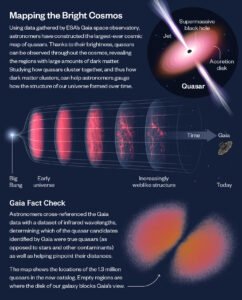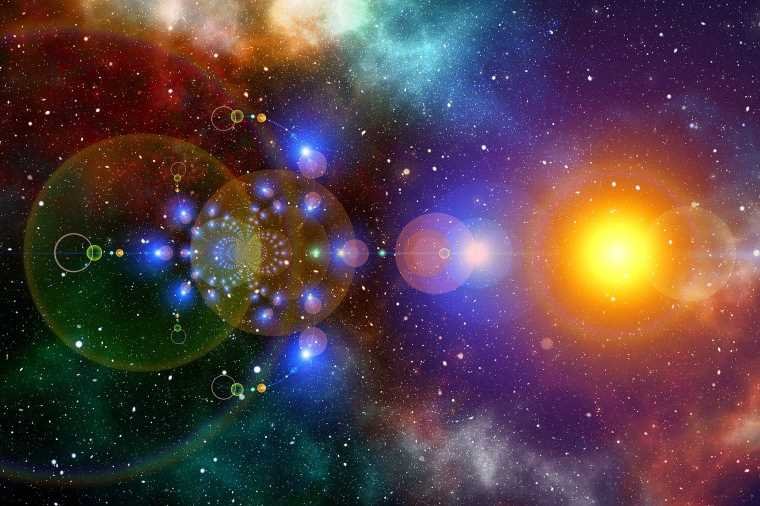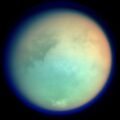An international team of astronomers has revealed a three-dimensional map of the known universe that charts the largest-ever volume of the extended cosmos. The tools used to create the map were initially designed to measure stars in our galaxy. However, their sensitivity revealed the locations of quasars powered by supermassive black holes at the centers of other galaxies, leading to the map’s eventual creation.
“This quasar catalog is different from all previous catalogs in that it gives us a three-dimensional map of the largest-ever volume of the universe,” says map co-creator David Hogg, a senior research scientist at the Flatiron Institute’s Center for Computational Astrophysics in New York City and a professor of physics and data science at New York University. “It isn’t the catalog with the most quasars, and it isn’t the catalog with the best-quality measurements of quasars, but it is the catalog with the largest total volume of the universe mapped.”
Map of the Known Universe Combines Data from Multiple Observatories
Fans of the movie Star Trek: Generations may recall the map of the known universe used by Captain Picard and Commander Data to track an anomaly across vast regions of space known as the Nexus. Of course, such a detailed map covering the entire cosmos has thus far existed only in the world of science fiction. Now, a team of Flatiron Institute researchers say they have created the first-ever real-world map of the known universe, bringing yet another concept from science fiction to science fact.
To create their map of the known universe, the researchers compiled data from the European Space Agency’s Gaia Space telescope, which included over 6.6 million quasar candidates. That data was then compared against observations collected by NASA’s Wide-Field Infrared Survey Explorer and the Sloan Digital Sky Survey, allowing the map’s creators to remove “noise” from the final product, including from other stars and galaxies, which resulted in a final 1.3 million quasars ending up in the final version of the map. The team also mapped dust and other “nuisances” that may block out certain quasars from observation.


As previously noted, Gaia’s primary mission involved mapping stars in the Milky Way Galaxy. However, the researchers behind this latest effort found that Gaia “inadvertently spots objects outside the Milky Way.” This includes supermassive quasars dating back to 1.5 billion years after the Big Bang.
“We were able to make measurements of how matter clusters together in the early universe that are as precise as some of those from major international survey projects—which is quite remarkable given that we got our data as a ‘bonus’ from the Milky Way–focused Gaia project,” explained the paper’s lead author, Kate Storey-Fisher.
While black holes themselves typically emit no light, quasars driven by supermassive black holes are often hundreds of times brighter than entire galaxies. That’s because the extreme gravitational pull of black holes at the center of galaxies collects and “spins up” nearby gas, resulting in an enormously bright disk that can be spotted across the space between galaxies. The result is a massive collection of bright objects that can be spotted by humanity’s most advanced telescopes, leading to the creation of the cosmic map.
New Map Already Paying Scientific Dividends
In their published study, which appears in The Astrophysical Journal, the researchers behind the largest-ever map of the known universe say their tool is already paying dividends. For instance, the data gathered by Gaia was recently compared against the light from the Big Bang, known as the cosmic microwave background. According to the researchers, this comparison will allow scientists to measure how matter clumps together throughout the cosmos.
The map is also likely to aid scientists who are trying to unravel the mystery of dark matter, as enormous rings of dark matter surround these individual quasars. In fact, the researchers say they expect their new largest-ever map of the known universe to aid astronomers and astrophysicists across a wide range of research efforts.
“It has been very exciting to see this catalog spurring so much new science,” Storey-Fisher says. “Researchers around the world are using the quasar map to measure everything from the initial density fluctuations that seeded the cosmic web to the distribution of cosmic voids to the motion of our solar system through the universe.”
“This quasar catalog is a great example of how productive astronomical projects are,” adds Hogg. “Gaia was designed to measure stars in our own galaxy, but it also found millions of quasars at the same time, which give us a map of the entire universe.”
Christopher Plain is a Science Fiction and Fantasy novelist and Head Science Writer at The Debrief. Follow and connect with him on X, learn about his books at plainfiction.com, or email him directly at christopher@thedebrief.org.

